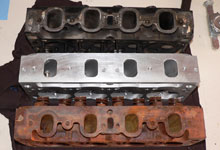|

by Jon Mikelonis
Introduction
Are 4V Cleveland heads OK for my application, or should I
run the 2V Cleveland head? The question can spur disputes
as fierce as rival religious sects jockeying for land rights.
In fact, the debate has been hashed out so many times within
the FordMuscle forums that we thought we'd add some fuel to
the fire in an pursuit for clarity on the subject. In this
article we'll gather flow and swirl test data, and take a
three-dimensional look at the design of Cleveland intake and
exhaust runners for Ford's factory 2V iron head, the factory
4V iron head, and Edelbrock's
Performer RPM 351C head. Once compared with basic cylinder
head theory and the often misunderstood topic of "swirl",
the results will provide you with a better understanding of
which head is best for your next Cleveland buildup whether
it's a 351C, Clevor, or the suddenly hip 351M/400.
| |
 |
351C Intake Ports. Is What You See
What You Get?
Pictured from top to bottom: factory iron 351C 4V, Edelbrock
Performer RPM 351C, and the factory iron 351C 2V cylinder
head. While the size of an intake port can provide an
indication of a cylinder head's flow potential, you've
got to get inside to see what's really going on. Page
two or this article will take you there. |
| |
Quick Cleveland
Head Facts
Complete lists, varieties, and other facts about the factory
and aftermarket canted valve "Cleveland" head are
available all over the web. With that said, this article is
not intended to be a reference to identify every Cleveland
casting produced nor is it intended to be a historical facts
and figures resource. The intention is to highlight new and
exclusive FordMuscle material on one of the most critical
and diverse aspects of all Cleveland heads designed for stock
manifolds; the intake and exhaust runners.
We'll venture forward assuming you
know the following basic facts about
the Cleveland cylinder head.
 Factory Cleveland heads were produced from 1970-1974
Factory Cleveland heads were produced from 1970-1974
 Factory
Cleveland heads can be found in both 2V and 4V castings Factory
Cleveland heads can be found in both 2V and 4V castings
 2V and
4V castings are available with and without a quench chambers 2V and
4V castings are available with and without a quench chambers
 All
Cleveland heads can be used on 351C, 351M, and 400 blocks All
Cleveland heads can be used on 351C, 351M, and 400 blocks
 Edelbrock,
CHI, and AFD all produce aluminum alloy Cleveland heads Edelbrock,
CHI, and AFD all produce aluminum alloy Cleveland heads
 Factory quench chambered 351C 4V Cleveland heads are identical
to Boss 302 Heads other than water jacket locations
Factory quench chambered 351C 4V Cleveland heads are identical
to Boss 302 Heads other than water jacket locations
For complete historical data on
the Cleveland see The
Ford 335-Series Engine at Wikipedia.
Basic Cylinder Head Theory
While combustion chamber design and volume, valve position,
and many other design aspects of a cylinder head have an effect
on useable power gains, the design characteristics of any
cylinder head's intake and exhaust port have the greatest
influence on airflow. This is why so much time and effort
is spent by DIY head porters and aftermarket engineering departments
on optimizing these areas of a cylinder head for the specific
applications in which the head will be used.
Again, while this article is not intended to be an absolute
reference on the Cleveland head or cylinder head theory, the
following excerpts from the SpeedPro Series book "How
To Build , Modify, and Tune Cylinder Heads" by Peter
Burgess and David Gollan", will provide you with
a basic foundation for which to evaluate the information presented
on the following pages.
"A
small intake port feeding a large cylinder will have a high
gas speed at low RPM, it will be unable to supply sufficient
air at higher rpm. Conversely, a very intake large port feeding
the same cylinder (think 351C 4V) will only achieve high gas
speeds at high RPM and will have very low gas speed at low
rpm. Standard port dimensions are the result of designers
aiming to achieve the best compromise in terms of filling
across a wide range of engine operating speeds."
"Airflow is more sensitive to shape than size, so big
ports are not necessarily better than small ports at flowing
air. Airflow also hates experiencing sudden changes in direction,
volume, and shape. These concepts are supported by the fact
that the areas of the port that are easy to get at (when porting)
normally have small to moderate effect on airflow; it is more
often those bits that are really difficult to get at that
usually have the greatest influence on the head's airflow
capability"
Both excerpts are applicable
to the obvious differences seen between a 351C 2V head and
a 351C 4V head, where the 4V's large intake port design is
known for better high RPM operation and the 2V's relatively
smaller intake port design is known for better low RPM or
street performance. Keep in mind however, that port volume
alone is just one aspect of an intake runner that contributes
to performance and drivability. Port shape and contour are
also critical factors, the following pages will take you inside
three different Cleveland cylinder heads to demonstrate the
variations in runner shape that affect flow performance.
 (Port
Mold Analysis, The Twist on Swirl, Flow and Swirl Testing) (Port
Mold Analysis, The Twist on Swirl, Flow and Swirl Testing)
|

